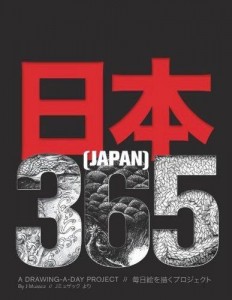JQ Magazine: Book Review — ‘Japan 365: A Drawing-A-Day Project’

“Using nothing more than the simplest tools at hand to capture the moment, the artist establishes a tangible reality that lends an urgency and authenticity to the work that would not be possible in a more polished and composed form.” (J Muzacz)
By Rafael Villadiego (Nagasaki-ken, 2010-13) for JQ magazine. A member of JETAA New South Wales, Rafael is a collector of words on a journey still searching for a destination, who has a tendency to forget, we are all sometimes like the rain…
“If you attach a reason to an adventure, it ceases to be one.” –Uemura Naomi, noted Japanese mountain climber and adventurer.
「冒険に理由をつけると、冒険でなくなってしまう。」植村直己
There is something timeless and romantic about the idea of the wandering artist. Drifting aimlessly down untrodden roads and stumbling across hidden paths. Going wherever the wind might take them and all the while sketching random scenes from daily life, in all its raw and unfettered glory.
Japan 365: A Drawing-A-Day Project by current Melbourne resident J Muzacz (Kyoto-fu, 2010-12) is a drawing-a-day project that sets out to capture this sense of artistic wonder, in a fitting meditation on contemporary Japan. A black-and-white reproduction of sketches produced with nothing more than a simple ballpoint pen and notebook, the project sets aside all pretension and gaudy artifice and pares everything down to its barest essentials and fundamental simplicity. It is especially gratifying to see some pieces scribbled on the back of old pieces of paper or second-hand timetables. Using nothing more than the simplest tools at hand to capture the moment, the artist establishes a tangible reality that lends an urgency and authenticity to the work that would not be possible in a more polished and composed form.
While by no means an artist myself, there is something to be said about living the dream: An errant dreamer recording the world as they see it unfold. However, such whimsical fancy fails to fully appreciate the hard work and dedication inherent to such an undertaking. Consciously choosing to actively produce a completed work of art, every single day, for a solid year, is no mean feat. Having it ultimately culminate into such a hefty tome worthy of sitting comfortably on any coffee table or bookshelf, and feeling the solid weight of it all in your hands, is nothing short of remarkable. Artist/writer Muzacz and his supporters must be heartily commended for seeing it to fruition.
The book makes the conscious decision to subdivide the artwork into broad sections that denote their thematic relationships. Ranging from landscapes and flowers to graffiti and gods, this makes for an intriguing structure and handy reference. While the drawings themselves necessarily take up the majority of the real estate, the insightful captions and humorous anecdotes add further depth and personality to each individual work. The fact that all the writing is completely bilingual in English and Japanese adds yet another dimension to the work and helps one to appreciate just what a comprehensive undertaking the completed project has been.
A specific chapter that must be singled out is the one dedicated to Tohoku and the aftermath of March 11, 2011. With the echoes of the twin disasters of the Great East Japan Earthquake and Tsunami still so close to home, and the ongoing crisis at the Fukushima Daiichi Nuclear Power Plant, this historical record sheds some meaningful light on the realities of the situation on the ground, and is a worthy testament to the indomitable strength and resilience of the human spirit. Particularly pertinent to those who were in Japan at the time and may have assisted with the immediate recovery efforts in the region soon after the disaster, it also serves as a firm reminder that the situation is far from over, and that there are still many families that continue to be displaced.
While the subdivision of the book into specific chapters does add necessary structure and aid in readability, I was glad that the artist also included thumbnails at the end of the book that displayed how the drawings came about chronologically. While this is but a personal preference, I would have found it fascinating to learn more about the process as it unfolded day-by-day—where, when, how and why he chose to draw and travel—as well as the artist’s personal thoughts and reflections at the time. Offering a presentation akin to a personal journal of the project as it came together over the course of the year may have added greater depth and intimacy to the work.
Quibbles aside, Japan 365 is a truly inspiring undertaking and worthy addition to any personal library. Speaking as a former JET who lived in Japan during the same period of time and visited many of the same regions and locales, the book offered a nostalgic recollection of the people and places I vowed to always remember and promised to never forget. If I could have captured them all in the same level of detail and clarity as Muzacz, I would have liked to produce such a tome myself. Instead, I will have to rely on nothing more than my own fleeting memory and take solace in the fact that there are worthy artists out there capable of encapsulating such perfect moments in time so well.
For more JQ magazine book reviews, click here.


Comments are closed.